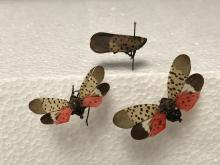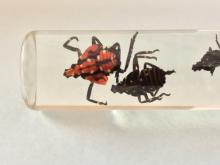The spotted lanternfly (Lycorma delicatula) is an invasive planthopper first documented in Pennsylvania in 2014 and has since spread to several other states. This insect feeds on important crops such as grape, hop, and fruit trees as well as many hardwood trees and nursery stock. Dead specimens were intercepted at cargo ports in California in 2019 and in Oregon in 2020. Agricultural Departments in Washington and Oregon have surveyed for live lanternflies in crops over the past couple years without finding them. We call on readers of this handbook to stay vigilant for the spotted lanternfly and immediately contact agricultural departments, invasive species councils, or university Extension in your state.
Description and damage When in flight, this brightly colored planthopper has wingspan of about 2 inches and is easy to spot due to the flashing red coloration on the hind wings. When at rest, these hind wings are hidden under light grey, spotted forewings. The newly emerged nymphs are black with white spots while the older nymphs develop a red body color with white and black spots. While the adults are mobile, we suspect that the greatest risk of the spread of this insect is due to the egg masses camouflaged to look like a smudge of mud found on various surfaces. At high densities, the adult female may lay the egg masses on just about any hard, smooth surface including vehicles, cargo crates, and much more. At high population densities, the spotted lanternfly reduces host plant vigor and productivity, but a primary problem is that this insect ejects large quantities of honeydew on surfaces beneath the infested plant including fruit and leaves. The honeydew feeds and promotes fungal growth that further stresses the host and discolors surfaces beneath the infested host including manmade surfaces like cars, decks, and the exterior of homes.
Biology and life cycle In the United States, the colorful adult planthopper is active from July to December. The nymphs are found on host plants between May and July. The egg stage is the overwintering stage for this species. While the adults and the nymphs can feed on the phloem of a wide range of plant species, the spotted lanternfly prefers to feed on tree-of-heaven (Ailanthus altissima), which is considered an invasive pest (weed) of its own throughout the PNW.
Pest monitoring Since the spotted lanternfly is not established in the PNW, early detection is the best defense against this pest. Shipments of plant material or cargo from in and around the quarantine area should be closely inspected. The easiest way to notice this pest is by scouting the base of host trees, plants, and crops for adult activity (when in flight, the adults display those red hind wings) and looking for signs of honeydew on surfaces beneath infested crops. While tree-of-heaven may be a good host plant to look for spotted lanternfly, removing this invasive plant from home landscapes and borders of host crops is strongly encouraged in any case.
For further information:
Wakie, T. T., L. G. Neven, W. L. Yee and Z. Lu. 2020. The Establishment Risk of Lycorma delicatula (Hemiptera: Fulgoridae) in the United States and Globally. Journal of Economic Entomology, Vol 113 (1) February 2020, Pages 306–314. https://doi.org/10.1093/jee/toz259
Oregon Department of Agriculture Fact Sheets and Pest Alerts. 2020 Spotted lanternfly 1113 - State of Oregon. https://www.oregon.gov/oda/shared/Documents/Publications/IPPM/SpottedLanternflyPestAlert.pdf



